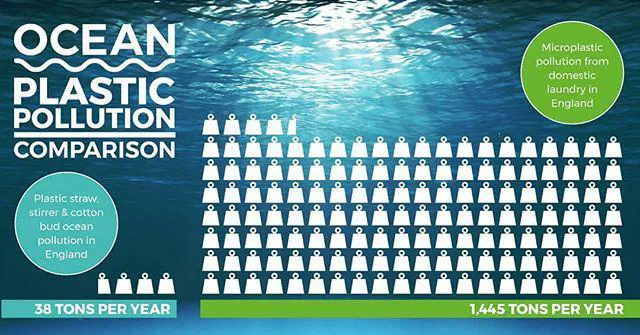By now most of us are all too familiar with the shocking statistics on plastics, of which nearly 350 million tonnes a year are produced. But what you might not know is that approximately 60% of our clothes are actually made of plastic. And to make matters worse, these plastic-based garments shed up to 17 million microplastics with every wash.
Microplastics are particulates of 5 millimetres and smaller. So, it may come as a surprise that these tiny fibres from apparel are the biggest source of microplastics entering our oceans. Yes, you read that right. At 35%, over one-third of ocean microplastics comes from synthetic textiles.
Indeed, you can see below that the amount of ocean pollution from plastic straws, stirrers and cotton buds pales in comparison to the plastic pollution caused by simply washing our clothes.

So how do these little microplastics end up on our plates?
Synthetic fabrics such as nylon, polyester and acrylic are an increasingly attractive material for making clothes and textiles due to being cheap and fast to create. Around 60% of clothes are made up of these plastic-based materials, and with no implications of reduced production, the problem is only set to worsen. So that pair of gym leggings, your trusted ski jacket or even your favourite t-shirt – are more than likely made from plastic derived materials.
Microplastics can be released when washing clothes in household washing machines – up to 17 million fibres in every wash. They’re too small to be caught at waste water treatment plants, and so, therefore, make their way through our country’s waterways, entering the ocean, and inevitably the food chain.
And here’s the thing. As soon as these pesky microplastics enter our waterways, they begin to absorb toxic substances. That includes everything from chemicals found in washing powders and pesticides, to deadly ocean spillages and the highly toxic chemicals that leach from anti-fouling paint on ships. All these chemicals are harmful to marine life, not to mention us humans – in particular our vital organs and nervous systems.
The polluting microplastics shed from our clothes have been found to be ingested by 100% of turtle species, 61% of marine mammals, 50% of seabirds and over 92 species of fish. So, you might want to think twice before ordering your next seafood dish.
Microplastics are also a thriving habitat for toxic bacteria, and when found in coastal areas can cause detrimental coral bleaching and loss of biodiversity. Further bacteria species that harm human health have also been detected, suggesting microplastics are an emerging vector for disease.
So whilst you may think the solution is to stop wearing plastic, unfortunately the problem doesn’t end there. Even more natural fabrics such as cotton, linen and wool can shed microfibres that end up in our waters. And even though they biodegrade at a faster rate, just like their synthetic cousins, natural fibres still absorb chemicals and toxins found in waters, which as we now know, eventually wind their way into our own bodies.
Incidentally, microfibres have also been found in soil, the air we breathe and the water we drink. But we’ll save that for another time.
So what can be done about microfibres?
If you’ve read this far, you may be feeling at a bit of a loss about the whole microfibre situation. But fear not, there are ways to make a difference.
It has been suggested that apparel businesses should industrially wash clothing in machines with suitable microfibre catchment technology to reduce the amount released when washed by consumers in domestic conditions.
Xeros Technologies, who provided the image above, also have a product called XFiltra™ which can be fitted in new washing machines and captures over 99% of fibres in a laundry wash. https://www.xerostech.com/technology#xfiltra.
At the consumer level, there are products such as ‘Guppy Friend’, a small bag that you can put clothes in to catch microfibres, and ‘Cora Ball’ which in the same way, catches fibres during washes, preventing them from entering our waterways.
And of course, you can always consider washing your clothes less frequently…
Want to find out more?



